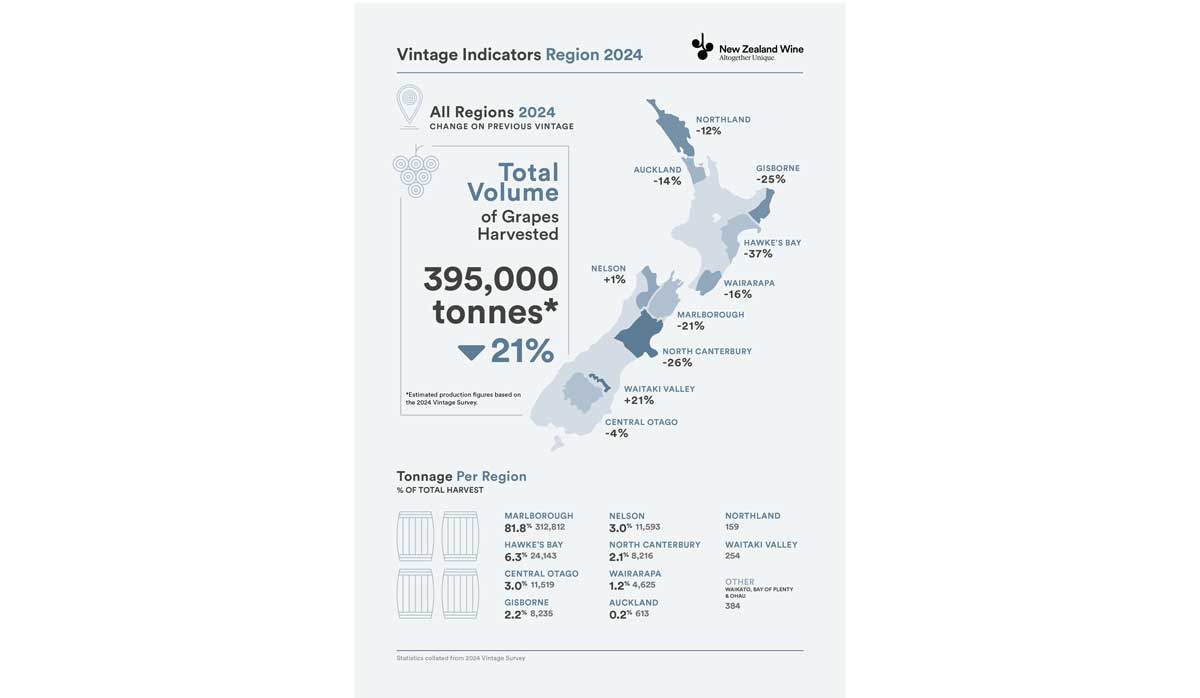New Zealand's wine regions harvested 395,000 tonnes of grapes in the 2024 vintage, which is 21% lower than 2023, nearly 30% down on the bumper 2022 crop, and slightly above the modest 2021 yield.
"After the roller coaster ride of the past four years, it's a fair question to ponder, 'is this the new normal?'" New Zealand Winegrowers (NZW) Chief Executive Philip Gregan told attendees at the three Grape Days events in June.
The 2021 and 2024 vintages are two of the three lowest yielding crops in the past ten years, despite growth in vineyard area, he said. "Sandwiched between them, vintages 22 and 23 are our two largest ever harvests."
Meanwhile, demand for wine is flat to declining, costs are up, and "there's an incredible degree of uncertainty about what's going to happen in the year ahead", Philip said, reflecting on "chaotic" GDP growth in 2020, and "anaemic" growth since mid-2023, with an impact on consumer spending.
A backdrop of high retailer inventory means the New Zealand wine industry is carrying much more stck that anyone projected at this time last year, "which is impacting profitability and cash flow", Philip said. "There's about 50 million litres of stock from vintage 23 out there that hasn't been sold in the past 12 months." The lighter vintage will go some way to rebalancing that, with total sales currently at 320 million litres and the 2024 vintage set to produce 20 million litres less than that.
NZW board Chair Clive Jones says wine companies can delay the release of the 2024 vintage, in orer to sell through 2023 stock. "We have got wine to sell. If we can get that wine to market over the next 12 months that's got to put us in a better position. But we still don't want a large harvest next vintage."
Regardless of what nature serves up for harvest 2025, winery capacity may be a limiting factor, he adds, noting that while wineries were empty leading into the 2022 and 2023 harvests, some tanks remained full going into vintage 2024 and the same can be expected going into the 2025 season. The industry has been bullish for the past couple of years, and now "it's a steady the ship phase", he says. "We need to be careful that we manage our way through."
A lot depends on the next 12 months, Clive adds, noting that the past three to four months of sales have been positive. "We would hop that we are going to see stronger sales in the next 12 months than we did in the last 12 months so we can get through the surplus."
Philip detailed a perfect storm of pressures being faced by winegrowers, including high interest rates and farm price inflation outstripping the Consumer Price Index. According to the Ministry for Primary Industries (MPI) Situation and Outlook for Primary Industries June 2024, "all parts of the industry are facing increased operating costs, further constraining profitability," he told Grape Days attendees.
Meanwhile, competition from other beverages is growing and health and wellness trends are impacting market demand for wine, contributing to growth in lower and zero alcohol products. Demographic changes are impacting markets, and government regulation and taxes are also having a major impact. "These factors are contributing to flat or declining markets for wine."
Export growth was "remarkably steady and consistent" through the 2010s, reflecting strong demand from key markets. "No wonder in 2010 that NZW felt confident to predict New Zealand wine exports would reach $2 billion in 2020, which they did." Fast forward four years, and wine export revenue is forecast to decrease 13% to $2.1 billion in the year to 30 June 2024, with a high degree of uncertainty about sales in the year ahead, Philip said.
On the plus side, looking beyond declining export numbers New Zealand wine is performing "solidly" in most markets, with NZW member webinars over the past six months revealing good in-market sales performance and opportunities. It's "certainly not spectacular" but performing better than most, and there are still opportunities in market, he said, noting that the MPI outlook report predicts Sauvignon Blanc demand will remain strong from 2025.
"That is not to deny the tough market conditions, that the small sales gains have been very hard to achieve, nor the many immediate challenges confronting growers and wineries," Philip said. "But the numbers confirm the reputation of New Zealand wine remains solid, and this a strong platform from which to build for the future."













